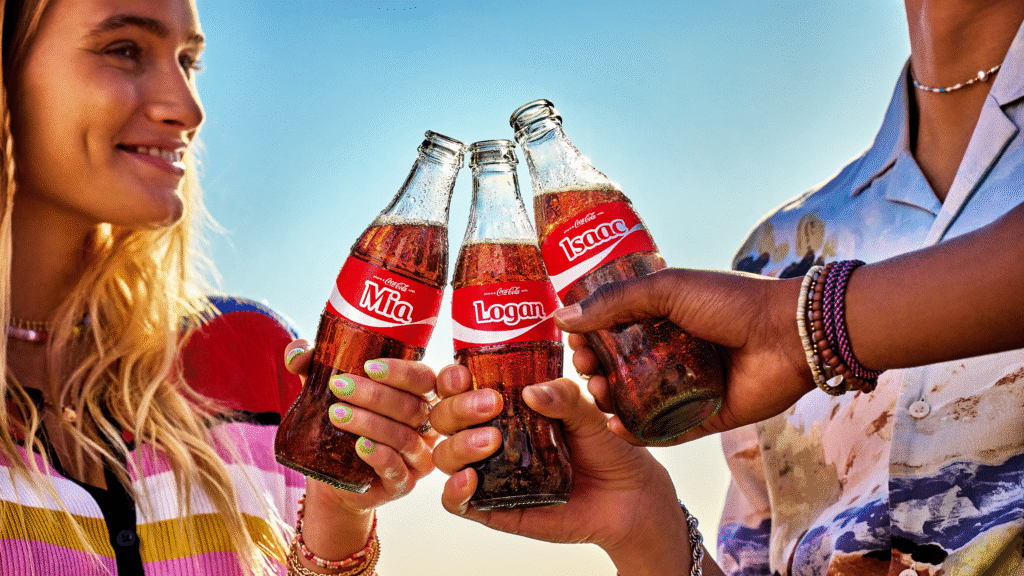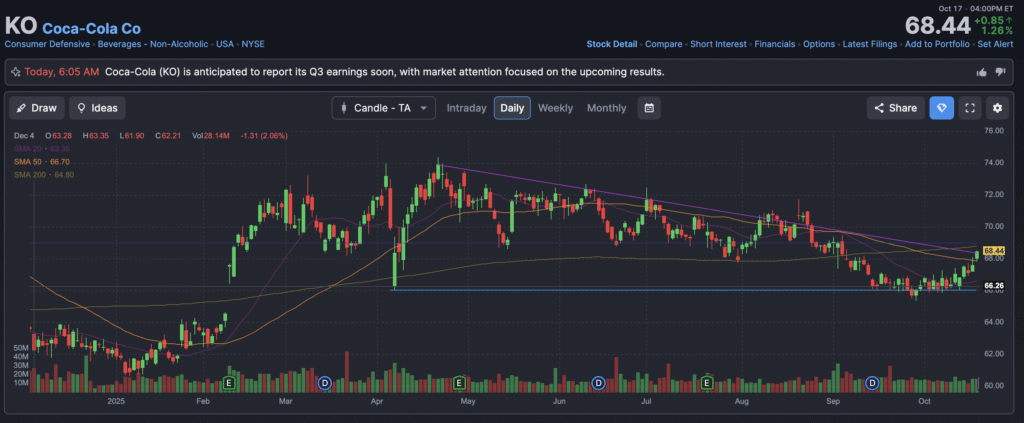The Coca-Cola Company is a global beverage giant headquartered in Atlanta, Georgia. It produces, markets and sells a broad portfolio of nonalcoholic ready-to-drink (NARTD) beverages, including its flagship Coca-Cola brand, whites, waters, energy and coffee drinks. The company operates in more than 200 countries through a franchise bottling system, working with over 700,000 people in the “Coca-Cola System”.
Over many decades, Coca-Cola has built one of the world’s most recognised brands and leverages scale, marketing, and global distribution to maintain leadership. The business model focuses on concentrate and syrup production rather than owning all bottling operations.
It also emphasises sustainability (packaging, water, climate) and product innovation (zero sugar, flavour extensions, premium offerings), in response to changing consumer tastes.
The company pays a regular dividend and is known for its defensive qualities in a consumer-goods portfolio. While growth may be slower than high-flying tech, its brand strength and global footprint provide stability.
Going forward, Coca-Cola is navigating headwinds including volume declines in certain regions, currency/foreign-exchange pressures, commodity and input inflation, and evolving consumer preferences (sugar reduction, premiumisation).

Recent Earnings (Latest Quarter)
For the quarter ended June 27, 2025, Coca-Cola reported EPS of approximately $0.88 per share (GAAP) and comparable EPS (non-GAAP) of $0.87, representing a 58 % reported increase and a 4 % comparable increase, with an 11-point currency headwind included.
Revenue for the same period was about $12.50 billion, with organic revenue growth of 5 % and volume down around 1 %.
While the EPS beat analyst estimates (non-GAAP $0.87 vs expected $0.83) according to MarketBeat, revenue missed slightly ($12.50B vs ~$12.55B expected).
The company provided full-year guidance (currency-neutral comparable EPS growth) of ~8 % and organic revenue growth of ~5–6 %.
So, the takeaway: strong profitability margin control (especially given FX headwinds) but modest volume challenges, headline revenue slightly under expectations and volumes facing pressure.
Founding, History, Products, Headquarters & Key Competitors
The Coca-Cola Company traces its roots to the late 19th century: the original Coca-Cola drink was invented in 1886 in Atlanta, Georgia. The company was formally incorporated in 1892 under founder Asa Griggs Candler.
Headquartered in Atlanta, Georgia, USA, the company serves a global market via its franchise system and more than 200 brands across categories (carbonated soft drinks, waters, juices, teas, ready-to-drink coffees, energy beverages).
Coca-Cola’s product portfolio includes the flagship “Coca-Cola” brand, Diet Coke/Coke Zero, Sprite, Fanta, Minute Maid juices, Dasani water, Powerade sports drinks, and other premium and functional beverages. It also has investments and partnerships in coffee (e.g., acquisition of Costa Coffee).
Its business model primarily involves manufacturing concentrate and syrup, selling it to independent bottlers (or company-owned bottling operations) which then manufacture, package and distribute the finished beverage products. This “Coca-Cola system” means the company is less asset-intensive than full vertically-integrated comparators.
Key competitors include PepsiCo, Inc. (global beverages and snacks), Keurig Dr Pepper Inc. (primarily U.S. beverages) and other regional beverage players. In the carbonated soft drink market particularly, Coca-Cola has the largest market share globally.
Market & Growth Expectations
The company operates in the non-alcoholic ready-to-drink (NARTD) beverage market, which is large, global and fairly mature in many developed economies, yet still has growth potential in emerging markets, premiumisation, functional drinks, zero-sugar variants, value formats and geographic expansion.
For example, in 2024 Coca-Cola reported net revenues of about $47.06 billion, up about 2.9 % compared to 2023 (~$45.75 billion) according to MacroTrends.
Over the 2021-2024 period, some sources suggest a revenue CAGR of approximately 7 % for Coca-Cola, slightly exceeding some of its peers.
Looking toward 2030, the growth driver will likely come from: emerging markets (Asia, Africa, Latin America) where per-capita beverage consumption remains below developed markets; premium and functional beverage segments (e.g., low/calorie, no-sugar, enhanced waters); brand extensions and geographic expansion; productivity and cost management; and packaging/format innovation.
However, given market maturity in developed regions, high competition and commodity/FX headwinds, the overall market in developed economies may grow at modest mid-single digit rates, while emerging markets could grow faster. For example, some bottler guidance (e.g., Coca-Cola Europacific) expects annual growth around ~4 % in 2025 in their markets.
Competitors
PepsiCo is the primary global competitor: it has a broader portfolio (beverages + snacks) and higher revenue (~$91 billion for 2024) compared to Coca-Cola’s ~$47 billion.
Keurig Dr Pepper is another U.S. competitor in beverages, particularly in carbonates, mixers, and non-alcoholic drinks. But its scale is smaller compared to both Coke and Pepsi globally.
In the soda wars context, Coca-Cola remains the number one brand globally in non-alcoholic soft drinks and competes heavily on branding, pricing, innovation, and distribution.
Unique Differentiation
Coca-Cola’s differentiation lies in its unrivalled global brand recognition, distribution scale, and franchise bottling system. The Coca-Cola brand is arguably the most valuable beverage brand in the world with deep consumer loyalty and consistent marketing investment.
Its asset-light model (focus on concentrate + syrup production) and bottling partner network give it flexibility and lower capital intensity compared to owning full manufacturing & distribution in every geography. This allows for higher margins and more scalable international growth.
Additionally, Coca-Cola’s breadth of product portfolio (200+ brands, thousands of beverages) positions it to adapt to changing consumer preferences (for zero sugar, premiumisation, functional beverages).
Finally, its global footprint with presence across developed and emerging markets allows for geographic diversification of risk and growth opportunities (e.g., growth in Latin America, Africa, Asia).
Management Team (Selected)
- James Quincey – Chairman and Chief Executive Officer of The Coca-Cola Company. Quincey heads the executive leadership team and is the face of the company’s global strategy.
- John Murphy – President and Chief Financial Officer (CFO). He oversees finance, accounting, investor relations and helps shape Coca-Cola’s capital allocation and performance metrics.
- Henrique Braun – President, International Development. He oversees growth and operations outside of North America which is critical for expansion into developing markets.
Financial Performance Overview (Last 5 Years)
Over the last five years, Coca-Cola has delivered moderate revenue growth, though with pressures from volume declines, currency headwinds and rising costs. According to data, the company’s 2024 revenue was $47.06 billion, following ~$45.75 billion in 2023. This implies a growth rate of about 2.9 % for 2024.
From 2021 to 2024, revenue reportedly rose from ~$38.7 billion to ~$47.1 billion – a rough 7 % CAGR over that period.
On earnings growth, the company’s comparable (non-GAAP) EPS grew by ~4 % in Q2 2025 and full-year comparable EPS growth guidance of ~8 % suggests modest earnings growth ahead.
Balance-sheet wise, Coca-Cola maintains strong cash flows, global scale, and invests in branding and marketing. While the company carries debt (common in FMCG companies), its credit profile remains solid thanks to cash-flow stability.
Overall, while growth is not explosive, Coca-Cola’s financial performance has been steady with decent margin control, particularly in managing input inflation and currency headwinds. The key concerns for financials are volume pressure, currency/FX risks, and commodity inflation which could compress margins if unchecked.
Bull Case
- Strong global brand and franchise network with ability to leverage pricing, mix improvement and geographic expansion.
- Growing exposure to emerging markets and premium/zero‐sugar/functional beverage categories which offer higher growth potential than mature carbonates in developed markets.
- Stable cash flow, regular dividend and potential for share buybacks make the stock attractive for income and core holding in a portfolio – resilience in economic downturns.
Bear Case
- Volume declines in key markets, especially developed ones, due to changing consumer tastes (health, low sugar) and competition could hurt growth.
- Currency/foreign-exchange headwinds, commodity inflation (packaging, aluminium, sugar), and cost pressures can squeeze margins and reduce profitability.
- Valuation appears stretched relative to growth (i.e., investors may be paying for stability rather than high growth) and slower growth could disappoint if expectations rise.
Analyst Reactions
Recent commentary includes a note from TipRanks indicating analysts at Bank of America Securities reiterated a Buyrating on Coca-Cola, with a price target of $78.00.
Other commentary (Seeking Alpha) suggests that while fundamentals are strong, some investors believe the valuation limits additional upside given rising concerns about volume decline and FX exposures.

The stock is in a consolidation stage 3 on the monthly chart, and stage 4 markdown on the weekly chart, but the daily chart is showing a cup and handle on the move higher in a stage 2 markup. The earnings should help the stock move higher to the $71 and if good should even help it to $74 all time highs.